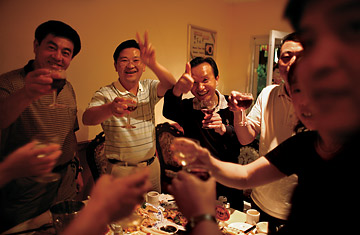
A surprise birthday party at a Chinese Restaurant in Johannesburg.
Past Miriam Makeba Street, between the empty lots and beat-up Edwardian piles that mark the edge of what, before crime hollowed out downtown Johannesburg, were some of the most imposing city blocks on the continent, stands an intriguing vision of Africa. Here, the Yung Chen Noodle Den and the Sui Hing Hong Wholesale and Chinese Gift Company rub shoulders with the Gold Reef Restaurant. "Ah, Africa," sighs William Lai, 60, as he gazes out across the great plains of parking lots that define Johannesburg's Chinatown. "Where I was born. Where my children were born. Home."
Fourteen years after the end of apartheid, its divisions and absurdities live on. Segregation may now be voluntary rather than legal, but South Africans still live in neighborhoods defined by skin color — white, black or "colored" [mulatto or descendants of slaves from the Dutch East Indies]. To address the iniquities of apartheid, the state decided it still needed to classify its citizens by race: The post-apartheid government instituted an affirmative action program called Black Economic Empowerment (BEE) to redress the massive imbalance of economic power in favor of whites. BEE legislation relies for the most part on apartheid's definitions of "black." It is held to cover those excluded from power and privilege in the old order — African, Colored and Indian. But although they were also excluded, Chinese South Africans were passed over. The Chinese community fought back, and on June 18 this year, it won a ten-year legal battle to redress that slight. At a stroke, around 10,000 Chinese South Africans who had been South African citizens under apartheid officially became black, qualifying for the benefits of the BEE.
The High Court judgment caps a bewildering few centuries for the Chinese of South Africa. Lai, who runs a guitar and amplifier repair shop, steers me a few doors down to Sui Hing Hong and a book called Colour, Confusions and Concessions: the History of Chinese in South Africa by Melanie Yap and Daniel Leong Man. It documents how a tiny minority in a land delineated by race have long been abused from all sides. Many arrived in South Africa as virtual slaves, convicts imported as manual laborers by the Dutch and, later, the British. Their second-class status was formalized after World War II as the newly elected National Party government instituted the apartheid system that denied non-whites the right to vote, to work in certain jobs or live where they choose, and imposed countless other restrictions.
In the often bizarre system of weights-and-measures used by the apartheid state to classify people for purposes of separating them, Chinese South Africans were first deemed "Asiatic," then "Colored," and finally "the Chinese Group, which shall consist of persons who in fact are, or who, except in the case of persons who in fact are members of a race or class or tribe referred to in paragraph (1), (2), (3), (5) or (6) are generally accepted as members of a race or tribe whose national home is in China." Thus Population Registration Act of 1950, whose tortured language underlines the difficulties of creating an objective and rational basis for codifying racism. And a Chinese South African called David Song soon made a mockery of it.
In 1962, according to Yap and Man, Song applied successfully to be reclassified as "white" on the grounds that he associated with whites and was "generally accepted" as one. On March 23, 1962, the liberal Rand Daily Mail remarked: "Under the kind of legislation which allows an admitted Chinese, born in Canton, to be declared a White South African, anything can happen." Apartheid had "no accepted scientific basis," the paper editorialized, and attempting to "define the indefinable," inevitably resulted in "humiliating" and "endless" disputes.
Yap and Man also reveal evidence that Chinese may have settled in Africa long before the 17th century arrival of settlers from Europe. The first known map of southern Africa was drawn by Chinese cartographer Chu Ssu-pen in 1320. Sung dynasty porcelain (960-1279 AD) has been found at archaeological digs in Zimbabwe and South Africa. Chinese admiral Zheng He explored Africa's east coast between 1405-1433. Most compelling of all, until a few years ago, there lived, north of Cape Town, tribes with light colored skin, Mongolian features and a language tonally similar to Mandarin, who traced their origins to 13th century Chinese sailors and call themselves Awatwa or "abandoned people." Given the fact that not only the white population, but also the black African population migrated to what is now South Africa from further afield, Chinese South Africans feel as rooted here as anyone else.
As the authors of apartheid found, when you try to order humanity according to race, you quickly descend into tragicomedy. Lai's friend Edwin Chang, 50, a caretaker, says he's lived with this absurdity all his life. He was born in South Africa to immigrants from the southern Chinese city of Guangzhou, grew up in black townships and speaks English, Afrikaans and Zulu. "Some say we are black, some say we are Asian, some say we are colored, some call me a Boer [a collective term for Afrikaans-speaking white people]," he says. "It's confusing. Where do we stand? How should people relate to us?" As apartheid discovered and the post-apartheid government is learning anew, the answer is neither black nor white, but African.
